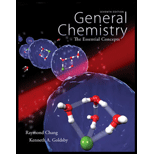
Concept explainers
(a)
Interpretation: For the aqueous
Concept introduction:
Molality: Molality is defined as number of moles of the solute present in the specified amount of the solvent in kilograms.
Moles: One mole is equivalent to the mass of the substance consists same number of units equal to the atoms present in
From given mass of substance moles could be calculated by using the following formula,
Mass: It is the quantitative measure of a substance. The amount of matter present in substance is expressed as mass. The
(a)
Answer to Problem 13.17QP
Molality of
Explanation of Solution
Given data: Strength of sugar solution
Density of sugar solution
Calculation of mass of sugar:
Substitute the value of strength of sugar and molecular mass of sugar in the formula to calculate mass of sugar.
Molecular weight of sugar
Calculation of mass of sugar solution:
Calculation of molality of the solution:
Substitute the value of moles of sugar and amount of solvent (water) into molality formula to calculate molality of sugar solution.
(b)
Interpretation: For the aqueous
Concept introduction:
Molality (m): Molality is the number of moles of solute present in one kilogram of solvent. Molality is estimation of moles in relationship with solvent in the solution.
Moles: One mole is equivalent to the mass of the substance consists same number of units equal to the atoms present in
From given mass of substance moles could be calculated by using the following formula,
Mass: It is the quantitative measure of a substance. The amount of matter present in substance is expressed as mass. The
(b)
Answer to Problem 13.17QP
Molality of
Explanation of Solution
Given data: Strength of Sodium hydroxide solution
Density of Sodium hydroxide solution
Calculation of mass of
Substitute the value of strength of
Molecular weight of
Calculation of mass of
Calculation of molality of the solution:
Substitute the value of moles of Sodium hydroxide and amount of solvent (water) into molality formula, to calculate molality.
(c)
Interpretation: For the aqueous
Concept introduction:
Molality (m): Molality is the number of moles of solute present in one kilogram of solvent. Molality is estimation of moles in relationship with solvent in the solution.
Moles: One mole is equivalent to the mass of the substance consists same number of units equal to the atoms present in
From given mass of substance moles could be calculated by using the following formula,
Mass: It is the quantitative measure of a substance. The amount of matter present in substance is expressed as mass. The
(c)
Answer to Problem 13.17QP
Molality of
Explanation of Solution
Given data: Strength of Sodium bicarbonate solution
Density of Sodium bicarbonate solution
Calculation of mass for
Substitute the value of molecular mass and strength of Sodium bicarbonate to calculate mass of
Calculation of molality for given solution:
Substitute the value of moles of Sodium bicarbonate and amount of solvent (water) into molality formula to calculate molality of the given solution.
Want to see more full solutions like this?
Chapter 13 Solutions
Package: General Chemistry with Connect 2-year Access Card
 ChemistryChemistryISBN:9781305957404Author:Steven S. Zumdahl, Susan A. Zumdahl, Donald J. DeCostePublisher:Cengage Learning
ChemistryChemistryISBN:9781305957404Author:Steven S. Zumdahl, Susan A. Zumdahl, Donald J. DeCostePublisher:Cengage Learning ChemistryChemistryISBN:9781259911156Author:Raymond Chang Dr., Jason Overby ProfessorPublisher:McGraw-Hill Education
ChemistryChemistryISBN:9781259911156Author:Raymond Chang Dr., Jason Overby ProfessorPublisher:McGraw-Hill Education Principles of Instrumental AnalysisChemistryISBN:9781305577213Author:Douglas A. Skoog, F. James Holler, Stanley R. CrouchPublisher:Cengage Learning
Principles of Instrumental AnalysisChemistryISBN:9781305577213Author:Douglas A. Skoog, F. James Holler, Stanley R. CrouchPublisher:Cengage Learning Organic ChemistryChemistryISBN:9780078021558Author:Janice Gorzynski Smith Dr.Publisher:McGraw-Hill Education
Organic ChemistryChemistryISBN:9780078021558Author:Janice Gorzynski Smith Dr.Publisher:McGraw-Hill Education Chemistry: Principles and ReactionsChemistryISBN:9781305079373Author:William L. Masterton, Cecile N. HurleyPublisher:Cengage Learning
Chemistry: Principles and ReactionsChemistryISBN:9781305079373Author:William L. Masterton, Cecile N. HurleyPublisher:Cengage Learning Elementary Principles of Chemical Processes, Bind...ChemistryISBN:9781118431221Author:Richard M. Felder, Ronald W. Rousseau, Lisa G. BullardPublisher:WILEY
Elementary Principles of Chemical Processes, Bind...ChemistryISBN:9781118431221Author:Richard M. Felder, Ronald W. Rousseau, Lisa G. BullardPublisher:WILEY





